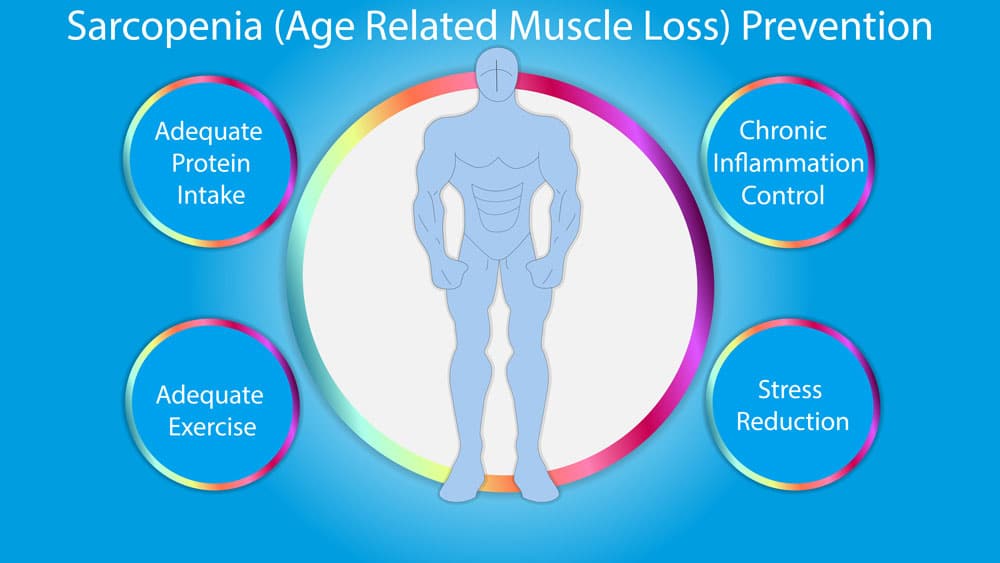There’s an epidemic in older people that you don’t hear enough about, and it contributes to other health problems. It also reduces the quality and length of life. No, it’s not type 2 diabetes or heart disease, it’s sarcopenia, a lesser-known health concern that robs people of their functionality and their metabolic health.
What is Sarcopenia?
Sarcopenia is the age-related loss of muscle mass and muscle function. It’s normal to gradually lose some muscle strength and mass as we age, and this occurs at variable rates depending on how active an individual is and the type of diet they eat. Research shows we lose 3 to 5% of our muscle mass each decade after the age of 30. Older people who are sedentary and eat a low protein diet tend to have lower muscle mass than those who are active and consume sufficient protein.
Along with the decline in muscle mass and strength, people with sarcopenia gain body fat. The combination of less muscle and more body fat is metabolically unhealthy and increases the risk of health problems like type 2 diabetes. The loss of muscle and muscle function in people with sarcopenia is a major contributor to frailty and falls. So, sarcopenia is scary stuff when you consider how it can impact how functional you are. Loss of muscle and muscle strength means loss of functionality.
A Formula for Preventing Sarcopenia
Wouldn’t you like to avoid sarcopenia as you age? Based on current research, there are three things you can do to lower your risk of developing sarcopenia as you age. Let’s look at each one.
Get More Omega-3s
Omega-3s are a type of polyunsaturated fatty acid. They come in two varieties: long-chain and short-chain. Ideally, you want more long-chain forms of omega-3s in your diet. You can convert a portion of the short-chain fatty acids you consume to long-chain, but the process is inefficient. Less than 15% of the short-chain omega-3s you take in are converted to the long-chain form. Not that short-chain omega-3s don’t have benefits, but we know less about them. Short-chain omega-3s are in plant-based, omega-3-rich sources such as flaxseed, chia, sesame seeds, hemp seeds, walnuts, and more. Long-chain omega-3s are the form you find in fatty fish, like wild-caught salmon.
Studies show that omega-3s may help older people preserve muscle mass as they age. One factor that contributes to muscle loss and aging is the low-grade inflammation that increases with age. Some experts refer to the age-related increase in inflammation as “inflammaging.” Because Omega-3s have anti-inflammatory properties, the may protect against inflammaging. Some research also suggests that omega-3s counter anabolic resistance, another common problem in older people that contributes to sarcopenia. People over the age of 60 often have muscles that are less responsive to growth signals that tell muscles to grow. A diet rich in omega-3s, preferably long-chain ones, may lessen anabolic resistance.
Dietary Protein
Protein is the macronutrient your muscles need to repair the damage they sustain when strength training. As muscles repair, muscle fibers increase in size and the muscle becomes larger. Protein always helps reduce the age-related loss of muscle tissue. Since adults over the age of 60 have some degree of anabolic resistance, meaning muscle protein synthesis is less robust in response to signals to grow. Studies show that consuming protein at every meal (20-30 grams) may enhance muscle protein synthesis and reduce muscle loss. Also, some sources suggest that the current recommendation of 0.8 grams of protein per kilogram of body weight is too low for older people. So, consuming more protein and distributing that protein evenly across all three daily meal is a strategy to reduce age-related muscle loss and prevent sarcopenia.
Strength Training
You knew this one would be one here! Muscles increase in size when you force them to work harder than they’re used to. Of course, you have to supply them with amino acids for building blocks and enough calories to keep your body out of a catabolic state. You must also use progressive overload to avoid reaching a plateau by gradually increasing the intensity of your workouts over time. Progressive overload is a universal principle that spans all age ranges. For preventing and treating sarcopenia, progressive resistance training is first-line therapy! So powerful is progressive resistance training for boosting muscle protein synthesis that only two weeks of training in a study boosted muscle protein synthesis in the elderly by 182%. To maximize the benefits, it’s important to include high-intensity training to maximally stimulate fast-twitch muscle fibers, the kind that are more impacted by aging.
The Bottom Line
Now you know three things you can do to avoid sarcopenia. You can’t avoid all muscle loss as you age but you can limit it by taking these measures. Avoiding sarcopenia is vital for staying functional and for your metabolic health.
References:
Age Ageing. 2019 Jan; 48(1): 16–31. Published online 2018 Sep 24. doi: 10.1093/ageing/afy169.
Curr Opin Rheumatol. 2012 Nov; 24(6): 623–627. doi: 10.1097/BOR.0b013e328358d59b.
Curr Opin Clin Nutr Metab Care. 2009 Jan; 12(1): 86–90. doi: 10.1097/MCO.0b013e32831cef8b
The Lancet. “Sarcopenia” June 29, 2019
Aging Clin Exp Res. 2019; 31(6): 825–836.
J Exerc Rehabil. 2018 Aug; 14(4): 551–558.
Health Day. “Seniors and Weightlifting: Never Too Late”
Aging Clin Exp Res. 2019 Jun;31(6):825-836. doi: 10.1007/s40520-019-01146-1. Epub 2019 Feb 19.
Annu Rev Gerontol Geriatr. 2016; 36(1): 205–228. doi: 10.1891/0198-8794.36.205.
Sarcopenia: The Mystery of Muscle Loss. Chantal Vella, M.S. and Len Kravitz, Ph.D.
European Review of Aging and Physical Activityvolume 9, pages109–117 (2012)
Related Articles By Cathe:
You Don’t Just Lose Muscle with Age, You Lose Muscle Quality
Exercise During Middle Age Protects Against Muscle Loss Later
4 Reasons We Lose Strength as a Result of Loss of Muscle as We Age
3 Characteristics of Healthy, Youthful Muscle That Change as You Age
Lack of Exercise Is Even More Harmful to Your Muscles as You Get Older
Do Women Have an Easier Time Maintaining Muscle Mass with Age Than Men?


